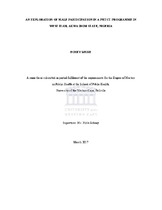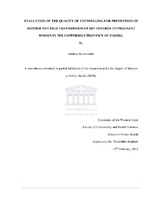| dc.contributor.advisor | Jackson, Debra | |
| dc.contributor.author | Woldesenbet, Selamawit | |
| dc.date.accessioned | 2014-11-06T10:14:40Z | |
| dc.date.available | 2014-11-06T10:14:40Z | |
| dc.date.issued | 2013 | |
| dc.identifier.uri | http://hdl.handle.net/11394/3810 | |
| dc.description | Master of Public Health - MPH | en_US |
| dc.description.abstract | Two quantitative studies were carried out in randomly-selected facilities within all
nine provinces of South Africa. First, a situational assessment of these randomly
selected facilities was undertaken using key informant (health care personnel)
interviews and record reviews to ascertain guidelines and procedures for early
identification of HIV-exposed infants (HEI), the coverage of early infant diagnosis
services, the human resource capacity of the health system, and existing linkage and referral system for antenatal and postnatal PMTCT services. This was followed by the South African national PMTCT survey (SAPMTCTE) which involved a collection of infant blood samples and maternal interview data from mother-infant pairs (infants age 4-8weeks) attending six weeks immunisation service points in the
selected facilities. Interviews were conducted with mothers to assess antenatal and
peripartum PMTCT services received and maternal intention to request for infant
HIV testing at six weeks immunisation visits. Data on gestational age at birth, infant
birth weight and HIV status was extracted from the road-to-health-card (RtHC).
The HIV status of mothers was determined from maternal report or enzyme
immunoassay (EIA) test conducted on infants dried blood spots (DBS). A weighted
analysis (weighted for sample size realisation and population live births) was
performed to assess uptake of services along the PMTCT cascade. Mothers who
either self-reported an HIV-positive status or had an EIA positive infant were
classified as HIV-positive mothers. Perinatal ARV regimen coverage was calculated
from the total number of HIV-positive mothers who received maternal azidothymidine (AZT) or HAART for any duration during pregnancy plus infant
nevirapine (NVP)/AZT received at birth. Descriptive methods were used to analyse
national availability of EID services and approaches for identifying HEI at the six
weeks immunisation visit. Logistic regression assessed key factors influencing
maternal intention to receive EID. Logistic regression was also used to explore
individual, health facility and provincial level factors that explain variability in
mother-to-child-transmission rates. | en_US |
| dc.language.iso | en | en_US |
| dc.subject | PMTCT | en_US |
| dc.subject | PMTCT cascade | en_US |
| dc.subject | Missed opportunities | en_US |
| dc.subject | EID service | en_US |
| dc.subject | EID service coverage | en_US |
| dc.subject | Uptake of PMTCT service | en_US |
| dc.subject | Loss to follow-up | en_US |
| dc.subject | Linkages | en_US |
| dc.subject | Health system factors | en_US |
| dc.subject | Risk factors of transmission | en_US |
| dc.title | Coverage, quality and uptake of pmtct services in south africa: results of a national cross-sectional pmtct survey (sapmtcte, 2010) | en_US |
| dc.rights.holder | uwc | en_US |




